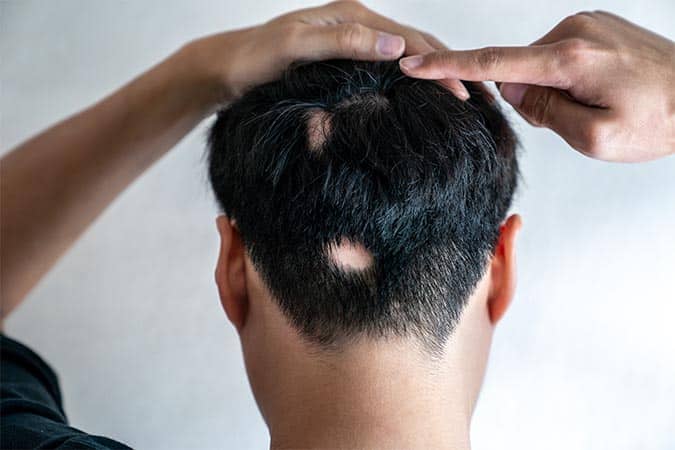What is Hair Loss (Alopecia)?
If you’re noticing your hair is starting to thin on your scalp, recede back, or that it’s falling out more frequently, you might have a form of hair loss (alopecia). Hair loss may occur on the scalp, eyebrows, eyelashes, beard, and other areas of the body. While some patients lose hair in only a few places, others lose it in many areas.
Common symptoms of alopecia may include:
- Thinning hair
- Hair shedding- finding it in the shower drain, sink, hair brushes, pillowcases
- Itchy scalp
- Hair that doesn’t grow
- Finding bald patches
There are different types of alopecia areata. These forms include:
- Androgenic alopecia: Male or female pattern baldness
- Alopecia areata: One or more coin-sized patches appear.
- Telogen effluvium
- Central centrifugal cicatricial alopecia (CCCA)
- Frontal fibrosing alopecia (FFA)
- Traction alopecia
- Tinea capitis: Ringworm
- Lichen planopilaris (LPP)
- Discoid lupus erythematosus (DLE)
Who is a Good Candidate for Alopecia Treatment?
Individuals who believe they may have alopecia should see a dermatologist for assessment. During your consultation, your dermatologist will speak with you regarding your signs and symptoms and examine the areas of hair loss. The dermatologist may gently pull on the hairs at the edge of bald patches to see if they come out easily, and check individual hairs and hair follicles to see if they are abnormally shaped. An examination of your nails may also be performed. A dermatoscope might be employed during the examination. In some cases, a scalp biopsy or a fungal culture may be performed.
What to Expect During Alopecia Treatment?
There are treatment options to help the hair grow back. These treatments include:
Corticosteroids: These anti-inflammatory drugs are often used to treat alopecia areata, CCCA, LPP, FFA, and DLE. They are available as an injection into the scalp or other areas of the body, as a pill, or as an ointment, cream, foam, gel, or solution.
Spironolactone: A hormonal therapy aimed at treating female pattern alopecia.
Low dose oral minoxidil (LDOM): An exciting newer therapy employed to treat female pattern hair loss and other hard-to-treat forms of alopecia.
Finasteride: Frontal fibrosing alopecia and pattern alopecias often respond well to 5-alpha reductase inhibitors.
Hydroxychloroquine (Plaquenil): Can be used to treat immune-mediated hair loss conditions such as lupus and lichen planopilaris.
Topical immunotherapy: When there is a large amount of hair loss in alopecia areata, treatment with squaric acid dibutyl ester (SADBE) or diphencyprone (DPCP) may be a viable option. Chemicals are applied to the scalp to create an allergic reaction, which makes the hair grow back. This treatment must be repeated several times to keep the new hair growing.
JAK inhibitors: Baricitinib (Olumiant) is an oral therapy used for adults with severe alopecia areata that is unable to be treated effectively with standard therapy. Laboratory monitoring and close dermatologist follow-up is required.
Alternative Topical therapies: Our office uses the full spectrum of studied agents including topical minoxidil, retinoids, anthralin, calcineurin inhibitors, nutritional supplements, doxycycline, and compounded JAK inhibitors to help our patients regrow their hair.
Alopecia & Hair Loss FAQs
Can a dermatologist help with alopecia?
Can alopecia be caused by stress?
Can doctors help with alopecia?
Can hair grow back after it starts thinning?
Can you get alopecia at any age?
Following Alopecia Treatment
Following alopecia treatment, many patients notice an improvement in their hair growth. There is no downtime required following treatment, so patients can return to their everyday activities as soon as they feel comfortable. Your dermatologist will provide you with instructions on how to properly receive treatment, as well as post-treatment tips.
Schedule a Consultation
If you believe that you may have alopecia or are experiencing a great amount of hair loss, contact HMGS Dermatology today! We will be happy to help you schedule your consultation appointment with one of our dermatology team members.

Get Started With A Visit!
Fill out the form below and we will reach out to you shortly to schedule an appointment.